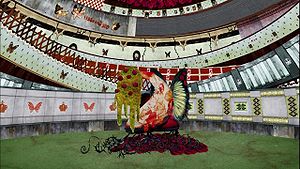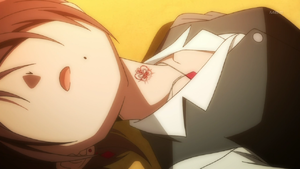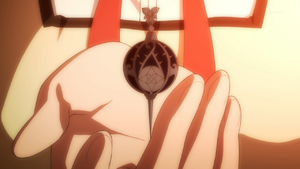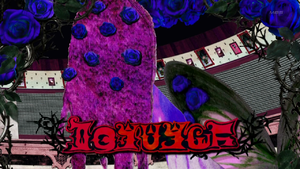Witch
Please refrain from reading if you are not yet familiar with all the latest media released.

A Witch is a monstrous creature that appears across the Puella Magi franchise. A Witch spreads malice and hatred through the world while, according to Mami Tomoe, it is the duty of Magical Girls to spread hope. When defeated, a Witch usually drops a Grief Seed that is used to purify the darkness in Soul Gems.
Episode 8 reveals that Witches are the final form of Magical Girls. When a girl's Soul Gem becomes too full of impurities and turns completely black, it transforms into a Grief Seed, and its Magical Girl becomes a Witch. Witches from the past seem to have nouns and nicknames for people as their names rather than traditionally feminine names.
As revealed in Magia Record, witches are capable of, and can be made stronger by, consuming Grief Seeds and other witches.
Also in Magia Record, Magical Girls can harness the power of their Witch as Doppels.
Witch's Kiss

A Witch's Kiss is a marking, the personal symbol of the Witch, used by a Witch and its Familiars to control the minds of humans. They can be used to exacerbate pre-existing negative emotions and thoughts, change personalities, make people commit crimes or suicide, or lure them into a Labyrinth to be consumed by the Witch inside. While some of these actions may not necessarily lead humans to being consumed, some Witches may also desire merely to spread evil and misfortune regardless of if they get sustenance. Further, a Kissed human may not always die from it. Familiars can Kiss humans well outside of the Labyrinth they hail from in order to bring them to their Witch.
In the original series, Witch's Kisses were only depicted as appearing on people's necks. In Magia Record, they are now shown to appear on any part of the body, including the face and limbs.
In the original series, Kazumi Magica and Magia Record, it is shown that humans with magical potential (future Magical Girls) can still become Kissed. It is unconfirmed, though implied in Rebellion, that even contracted Magical Girls can also be Kissed under special situations.
The symbol that makes up a Witch's Kiss also appears at the entrance of its owner's Labyrinth.
Familiars
Lesser monsters divided out of the essence of a Witch. After gathering enough energy, usually through eating enough people, a Familiar can turn into a Witch.
For more information, see Familiar.
Grief Seed

A witch's egg, which usually appears after a witch is defeated.
When a Soul Gem contains too many impurities and becomes completely black, it will transform into a Grief Seed, and its Magical Girl will become a Witch. All Grief Seeds drain impurities when used on a dim Soul Gem, replenishing a girl's magic and staving off their transformation into a Witch. In episode 6, Kyubey warns that absorbing too many impurities can revive the Witch. A Grief Seed that has been used before and already contains impurities will be unable to fully cleanse a Soul Gem. Due to unknown reasons, a Witch is not always guaranteed to leave behind a Grief Seed when defeated. This has been theorized to be at random, due to the attack also destroying the Grief Seed inside the Witch, or due to the Witch choosing not to leave one behind, but the reason is ultimately unknown.
Because of how valuable they are, Magical Girls may also use Grief Seeds to test if they can cooperate with another Magical Girl; rejecting an offered Grief Seed from another Magical Girl means refusing to work with them and hostility. Both Mami and Homura performed such kinds of tests.
As shown in Magia Record:
- Grief Seeds can be consumed by Witches and make them stronger.
- They are also confirmed to exist within the bodies of the Witches that own them.
- Grief Seeds are originally Soul Gems that have been influenced by emotions. Inside Grief Seeds is an energy similar to an iPS cell, a type of stem cell within living organisms, which can "become any emotion".
- Grief Seeds can be reached and stimulated by the hydrogen line, a specific radio wave used to send and receive signals during searches for extraterrestrial intelligence; it can penetrate through any obstacle, including the bodies of Witches, and resonate with their Grief Seeds within, allowing whoever is sending the signal to stimulate and manipulate their emotions.
- Touka Satomi further explains that, somehow, the hydrogen line can be emitted "with brain waves", such as brain waves used in hypnotism and waves that are emitted when one is excited, meaning that Witches can also feel others' emotions.
- Grief Seeds can be reached and stimulated by the hydrogen line, a specific radio wave used to send and receive signals during searches for extraterrestrial intelligence; it can penetrate through any obstacle, including the bodies of Witches, and resonate with their Grief Seeds within, allowing whoever is sending the signal to stimulate and manipulate their emotions.
See this page for list of Grief Seeds in the franchise.
Witch's Heart

The Witch's heart, also called "cuore maleficus", is a physical manifestation, or flesh of the Witch's life. When retrieved in a specific way through magic, it does not disappear like the rest of the Witch. The flesh of the Witches has been referred to with many names, such as "evil stuffing", "stuffed Witch" or "malefica farce" and it was used by the Pleiades Saints in combination with a human body to create Witch Hybrids. It is unknown if all Witches have an actual "heart" component, or if the flesh of a Witch is enough for the process.
Witch Hybrids
A sapient being created by a Witch's Heart and a human body. A hybrid sometimes has the abilities of the Magical Girls that were used to create them, as well as the abilities of the original girl who turned into its parent Witch. They progressively become more Witch-like with time and use of their abilities, similar to normal Magical Girls.
Hybrids can sometimes have their own version of a Soul Gem, in which case they're able to transform into their magical form, otherwise they will seemingly be permanently stuck in that form without the need for transformation. Hybrids of the same Witch have cannibalistic and amalgamate properties, as they can consume their siblings to gain their power, as well as willingly give their own to them. A Hybrid making a contract with Kyubey is not unheard of.
Pseudo-Witches
A creature that appears when an adult woman is imbued with an Evil Nut. They have around equal power to a Witch.
For more information, see Pseudo-witches.
Terminology through time and culture
Witches seem to be collectively named with different terms, depending on the time period and area.
In modern Japan[1] and USA[2], as well as 15th century France[3], 13th century Tibet[4], and 11th century Norway, Denmark, and England[5] (specifically by Vikings stationing there), the term is generally simply Witch (魔女 Majo) for the main monster and Familiar (使い魔 Tsukaima) for the smaller ones, which are the terms used through most of the series.
The traditional term used by the Tokime Clan is Devil (悪鬼 Akki) for Witch and Devil's Underling (悪鬼の子分 Akki no Kobun) or simply Underling (子分 Kobun) for Familiar, though eventually most characters belonging to that faction updated their terminology to the more common "Witch" and "Familiar".
Based on Puella Historia: War Shamanesses of Kamihama, the term for Witch commonly used in Sengoku period Kamihama was Demon (妖魔 Youma). No term for Familiar seems to be known.
Based on Puella Historia: The Heiress of Yamatai, the term for Witch commonly used in Yamatai in 3rd century CE was Cursed God (祟り神 Tatarigami). No term for Familiar seems to be known.
Based on Puella Historia: Pax Romana's Sweetheart, the term for Witch commonly used in Pompeii in the 1st century CE was monster of myth (神話の怪物 shinwa no kaibutsu) or simply monster (怪物 kaibutsu). This would translate to Latin as monstrum fabulae. No term for Familiar seems to be known.
Based on Puella Historia: The Mirage of Alexandria, the term for Witch commonly used in Alexandria in the 1st century BCE was Evil God (魔の神 Ma no Kami). The dominant language spoken in Egypt at the time would have been Koine Greek, and this term would translate as κακή θεᾱ́ (kake thea). However, Ebony also remarks that Kyubey has been simply using the term "Witch", and quickly switches to it upon talking to the Tokime Clan who use that term. Familiars are known as Messengers of Evil Gods.
Witch Names

Witches will have a different name than their Magical Girl self, and they will always be written in Runes. A majority of these names will be human names, feminine, different than those of their former Magical Girl selves, and in a language other than Japanese (compared to most known Magical Girls being Japanese), but exceptions to all of these exist throughout the franchise. Most naming conventions established in each entry in the franchise were broken by Magia Record.
Nearly all Witch names match up with a name of a minor planet or asteroid.
Madoka Magica Witches
In Puella Magi Madoka Magica, the names of all Witches and their Familiars were thematically related to the series and its inspirations. Most Witches were named after women known to have some kind of relationship, direct or indirect, with Johann von Goethe, Richard Wagner, Pyotr Tchaikovsky, or their works. For example:
- Charlotte's name is shared by Charlotte Buff, a woman for whom Goethe had an unrequited love, on which he based his work The Sorrows of Young Werther and also happens to be a dessert, fitting with her food motif.
- Her Familiars, Pyotr and Polina, are respectively named after Pyotr Tchaikovsky (composer for The Nutcracker) and both Polina Semionova (a ballerina in The Nutcracker) and, possibly, Pauiline von Metternich, a woman important in the promotion of Richard Wagner's work.
- Gertrud, instead, is likely named after horticulturalist and garden designer Gertrude Jekyll, after whom Dr. Jekyll (from the novel Strange Case of Dr Jekyll and Mr Hyde was named. The novel dealt with a man splitting his mind into two personalities, one embodying his psychological shadow and repressed evil inclinations (similar to Witches).
- One of her Familiars, Adelbert, is named after botanist and author Adalbert von Chamisso, who wrote a story about a man selling his shadow to the devil (similar to Goethe's Faust).
- Elsa Maria, more indirectly, was named after Elsa Maria Asenijeff[Citation needed], who suffered many tragedies in her love life, including her husband leaving her for another woman (similar to Sayaka Miki and Kyosuke Kamijo).
The names of the Holy Quintet (sans Oktavia von Seckendorff and Kriemhild Gretchen), as revealed in Madoka Magica Portable and Rebellion, are taken from other sources and are more individual to the character.
- Ophelia is named after the character from William Shakespeare's Hamlet, who drowned herself after suffering from depression and madness caused by her lover (connecting her to Oktavia, the mermaid Witch).
- Homulilly's name is the first to incorporate an element of her human self's name (Homura Akemi), and both her design and her Familiars are also based on The Nutcracker.
Oriko Magica Witches
Like the original series, all Witches in Puella Magi Oriko Magica are given feminine human names, though the reasoning behind each is unknown.
In Magia Record, the Witch forms of some characters are given names with individual significance and which are written with Greek or Latin origins.
- Pistis is named after the Greek personification of good faith and trust.
- Latria, whose name was given in Magia Record, is named after the Latin word for "adoration".
- Sotria sounds similar to Latria, and is likely a Latinized modification of the Indian Sattriya dance (corresponding to her being the ballroom dancer Witch).
Kazumi Magica
In Puella Magi Kazumi Magica, instead of human names, most Witches' names are descriptive phrases or titles written in German (corresponding to Goethe's language). The exception is Hyades Daybreak, named after the mythological Greek sisters and star cluster, which is in contrast to the protagonist Magical Girl group the Pleiades Saints.
In Magia Record, the Witches of some characters are given names that also break the manga's naming conventions and are all Italian, referencing the frequent use of Italian in the manga. Carola is named after an Italian variant of Sleeping Beauty, Caterina may be named after the Italian fairy tale Catherine and her Destiny, and Antonio (a masculine name) may be named after the city of San Antonio, Texas.
Suzune Magica Witches
In contrast to all other entries, few Witches in Puella Magi Suzune Magica are given names, but none are named in Suzune Magica. They appear to a lesser degree than in any other series and tend to have human characteristics.
In Magia Record, the Witches of some characters are given names with individual significance.
- Carmen is potentially named after a Latin term referring to a poem, song, or prayer (referencing Suzune Amano's name meaning "heavenly bell sound"), or the titular character of Prosper Mérimée's novel who was headstrong and independent but stayed with an abusive man who ultimately killed her despite her knowing it would happen.
- Odette is named for the main character of Tchaikovsky's ballet Swan Lake, a woman who fell in love with a prince who vows only to love her, which will eventually break a curse placed on her. Ultimately, the prince instead decides to marry the black swan Odile (sometimes interpreted as being identical to Odette) instead of Odette, who (along with the prince) decides to commit suicide rather than remain cursed forever.
- Renard references the French word for "fox," derived from the Dutch trickster figure Reinaerde—a name so iconic it replaced the Old French word goupil. It may also allude to Jules Renard’s story Poil de carotte, about a redheaded boy using cunning to endure humiliation, mirroring Arisa’s wish for strength.
- Spica derives from the Japanese pronunciation of "speaker" (スピーカー, supīkā), reflecting its megaphone form and Chisato’s self-imposed justice, which deafens others with its noise. The name also evokes shion (紫苑), a blue aster flower symbolizing remembrance, tying into her guilt over her father’s lost dreams, as well as Chisato's own last name.
- Elise likely references the German dancer in Mori Ōgai’s The Dancing Girl, whom the protagonist abandons—paralleling Matsuri’s own abandonment by her loved ones.
- Clothette echoes Tinker Bell’s French name, Clochette ("little bell"), alluding to both its bell-adorned form and the mayfly’s (kagerou) fleeting lifespan.
Tart Magica Witches
Similar to Kazumi Magica, while most Witches in Puella Magi Tart Magica are unnamed, those that are have descriptive titles (this time in French) instead of human names. The only Witch named in the original manga is Crépuscule de La Reine (Twilight of the Queen).
In Magia Record, the Witches of some characters follow the manga's naming convention of descriptive French terms and phrases with one mild exception. La Pucelle de Blancheur (The White/Pure Maiden), Obscurite (Darkness), Enfant Terrible (Unruly Child, which is also a French term for a candid child who says embarrassing things). The exceptions to this rule are, Crépuscule de La Reine, which Magia Record establishes as a false name for Isabeau's Witch form, which actually shares her human name, and Pernelle's Witch, named after Hermes.
Magia Record Witches
The Witches of both the Magia Record game and anime adaptation mostly adhere to human feminine names, but also frequently use names and terms in the Japanese language, that refer to non-human subjects (places, objects, animals, etc.), or are masculine. All names have individual significance to each character.
Many Witch names reference the works of and people related to Kenji Miyazawa and Oscar Wilde, both of whose work inspired and are frequently referenced throughout the story. For example:
- Giovanna and Campanella are named after the two main characters of Miyazawa's Night on the Galactic Railroad.
- Box Wood is named for a plant, which is the translation of the Japanese name Tsuge, taken from an author who Miyazawa admired and who taught at his school.
- Shitori Egumo is a Japanese phrase meaning "I'm going alone", taken from one of Miyazawa's poems; Shitori Egumo's Familiar, Oscar, is named for Oscar Wilde, the author of The Happy Prince, which Egumo is inspired by.
- Wilde also write The Portrait of Dorian Gray, after which Old Dorothy is partially named (along with a woman who was identified as an alleged leader of a Wiccan cult).
- Giovanna, Pennen Nolde, and Pennen Nenemu are simultaneously named after Miyazawa's works and inspired by Wilde's The Happy Prince.
Witches whose names have individual significance and break the original anime's conventions make up a majority of Magia Record's Witches.
- Dee and Dum are references to Tweedledee and Tweedledum, twin brothers from Through the Looking-Glass that alternately get along and fight each other.
- Lakehurst is named for Naval Air Station Lakehurst, the site of the Hindenburg disaster.
- Breadman is named for the fairy tale The Gingerbread Man, about a living gingerbread man who cannot be caught.
- Cyan is likely intended to be short for cyanide, a poisonous chemical.
- Hund Balou is a combination of German and Portuguese that translates to "sheep dog".
- Halomonas Titanicae is the name of a protobacteria that feeds on the rust of sunken ships and is projected to cause the complete deterioration of the RMS Titanic.
- Zipzap is taken from the game Zip (also known as Zip Zap Zop) used as a theatre practice exercise.
- Slave of Anima is likely short for "Slave of Animation", referring to poor working conditions in the Japanese animation industry.
Magia Record is the first instance of numbers and Cyrillic letters being included in Witch names, as with 10^-43, 9daime Nue, Made in 168, and Маруся.
References
- ↑ Based on the original anime
- ↑ Based on stories focusing on Ashley Taylor
- ↑ Based on Puella Magi Tart Magica
- ↑ Based on Puella Historia: Rahkshasi of Tibet
- ↑ Based on Puella Historia: Valkyries of Vik